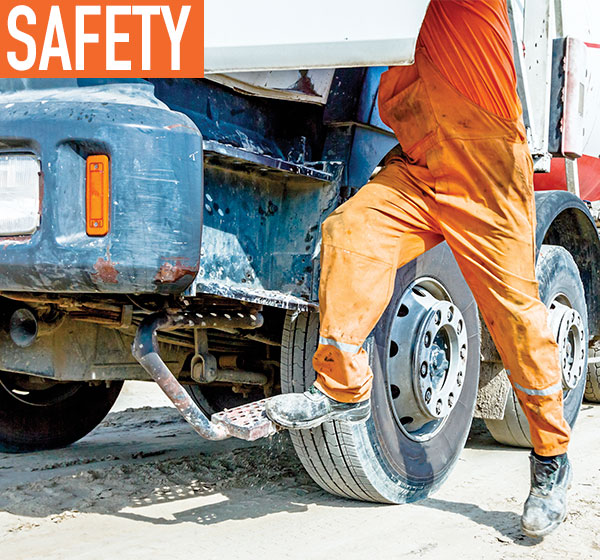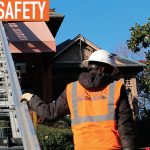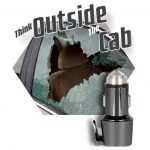Driving a truck can be a hazardous profession—and that’s before the driver has even set foot in the cab or put the vehicle in gear. For good reason, fleets focus much of their attention on minimizing risks on the road, but there are also risks when a driver is on his or her feet.
In fact, slips, trips, and falls may be the industry’s most overlooked threat to drivers’ health and wellbeing. Before developing a new online course on fall protection, CarriersEdge looked at how big the issue was—and it’s big. The Bureau of Labor Statistics’ data for 2017 show that 27 percent of injuries in the industry came from slips, trips, and falls versus just 17 percent from injuries sustained in a collision or other motor-vehicle related incidents.
Fleet managers who want to keep their drivers safe by reducing lost-time, accidents, and injuries (not to mention reducing injury claims) have an opportunity to make a significant difference. Most injuries can be prevented by following common-sense practices and with a little investment.
Invest in feet.
Don’t underestimate the value of your drivers’ feet. They use their feet every day to climb in and out of cabs, walk around shipping yards, and kick things out of the way. They need the best protection possible, and that does not come with cowboy boots, rubber overshoes, or flip-flops.
If you are not providing a shoe allowance for your drivers, consider it. It encourages drivers to invest in steel-toed, ANSI-certified safety shoes to protect their feet.
Jumping is for trampolines.
Some drivers have the bad habit of jumping from the backs of trailers, loading docks, and their cabs. It may seem like a short distance, but every time you jump down from even a short height, your body has to absorb the impact of the landing. The higher the jump, the higher the impact, with your joints and lower back taking the most punishment. As drivers age, those jolts to the joints will catch up to them—that is if they don’t immediately injure themselves by landing the wrong way.
But it’s not just about bad habits. If your equipment isn’t properly maintained and repaired, these slips and falls can occur because of missing or damaged steps and handholds. Check that drivers are both reporting these defects and getting a proper response from the shop.
Put it in a pocket.
Of course, the alternative to jumping is to climb using three points of contact (two hands and one foot or one hand and two feet). It may take a couple of seconds longer, but it’s worth it in the long run when compared to the cost and time lost from injuries. But when drivers are carrying tools or a phone, it may be a nuisance to have both hands free.
That’s where pockets come in—one of those simple technologies that we often take for granted but are extraordinarily useful, especially when you need both your hands.
Find safety vests that have pockets to add that extra layer of convenience, and provide them to drivers as part of their personal protective equipment. It’s easy to encourage people to use pockets, but they must be available.
Slippery when wet.
Drivers know water and ice make traction more challenging for tires. But it’s also problematic for shoes.
Puddles of water on a lot can be hazardous as you can’t see how deep they are or what’s at the bottom. And most people who have lived in wintery areas are familiar with the experience of having their feet fly out from under them in the middle of an icy parking lot.
Wearing a good pair of safety shoes with proper treads is essential, but so is awareness of conditions. If the temperature is cold or it’s raining, watch your step on metal surfaces such as cab steps or metal docks. If the temperature is hovering around freezing and there is snow on the ground, check for ice under the snow as well.
Drivers should also watch for other slippery substances on steps and docks such as oil and grease. Remember these substances might also be on your footwear as well as on the surface where you’re walking. For fleet managers, having a policy about keeping your site clean and clear of fuel or oil spills is essential. Everyone needs to understand and follow it.
Do they know how to use it?
Equipment such as a ladder or a fall arrest harness that is used incorrectly, worn, or in need of repair, can be as much a threat as a patch of ice or an oil spill on a metal step.
Fall arrest harnesses, for example, have to be inspected and worn correctly. An improperly worn harness not only won’t protect you, it can actually cause injury in the case of a fall. Train drivers on how to use them. Ask drivers to demonstrate that they can inspect and don the harness properly with a qualified trainer who can give them feedback.
BOTTOM LINE:
Slips, trips, and falls are a clear and present danger to your drivers and also to your company when it comes to injury claims. To truly have a partnership with your drivers in keeping them safe, think about these two things: how have you educated drivers on how to reduce the risk, and more importantly, what investments have you made to help drivers avoid injury.
ABOUT THE AUTHORS
Jane Jazrawy is CEO of CarriersEdge, a leading provider of online driver training for the trucking industry. She can be reached at .carriersedge.com.
MODERN WORKTRUCK SOLUTIONS: APRIL 2019 ISSUE
Did you enjoy this article?
Subscribe to the FREE Digital Edition of Modern WorkTruck Solutions magazine.





